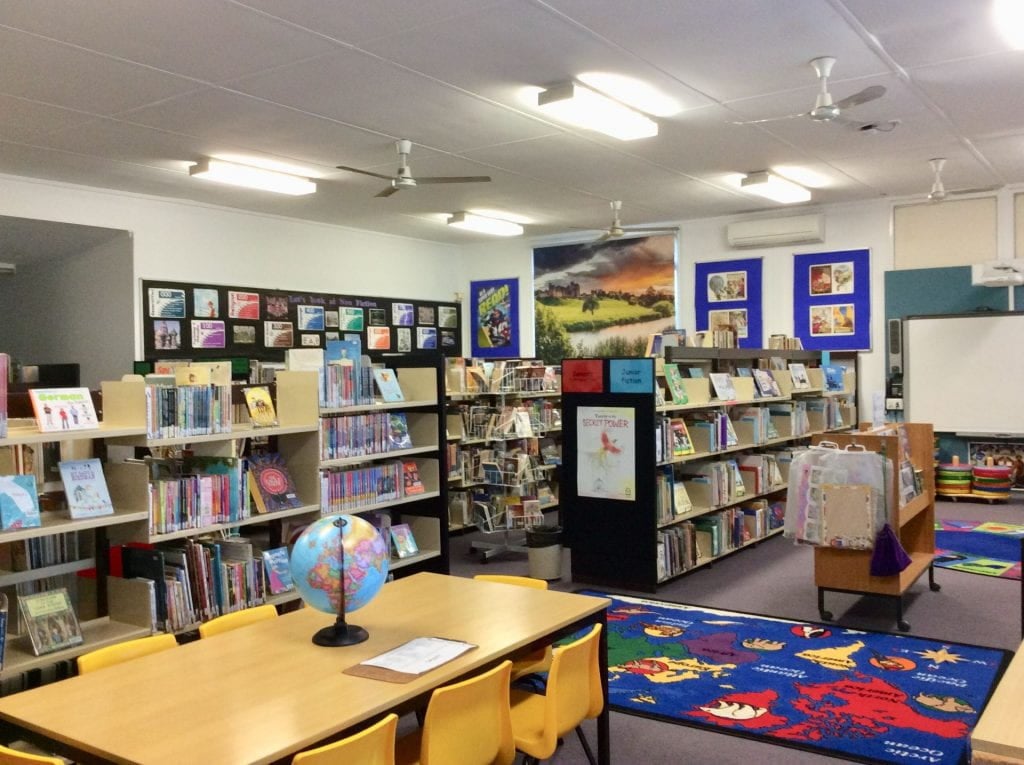‘My job is to help the teachers with their teaching and the children with their learning. I do that in whatever way I can.’
School: Pymble Public School Type: Primary K-6 Enrolment: 600+ Cataloguing subscription: SCIS Data + Authority Files Library management system: Oliver Library Software Size of collection: 18,000
The teacher librarian’s role
Kathryn is the only trained teacher librarian in the school. She has help in the library from another teacher who teaches classes and assists with circulation but does not assist with management tasks. There is also clerical support one day per week.
Kathryn runs the library herself. She buys and manages resources and assists teachers where she can, such as by recording programs to meet curriculum needs. One of her roles is to provide support for classroom teachers to provide specialist information services and teaching programs.
‘I see my job is to help the teachers with their teaching and the children with their learning. I do that in whatever way I can.’
Library collection

As a New South Wales government school, Kathryn’s library uses the Oliver library management system. She says that 15,000 items are standard library resources – books, posters, charts, big books, teacher reference materials. A further 3000 items, such as the computer software, the DVDs and the textbooks are in the school resources section – students can’t see these on the catalogue. Technology items, such as laptops, are not loaned through the library.
Kathryn and the English as an Additional Language or Dialect (EAL/D) teacher worked together to create a collection of books in languages other than English. ‘We’ve got a Community language section which has the non-English books. These are books in some of the languages represented within our school community’.
Everything in the library is catalogued. Kathryn lends nothing that isn’t on the system, although she admits that she sometimes lends her stapler but says, ‘It’s out and back for the day!’
SCIS for over 30 years
Kathryn has been in school libraries for 30 years and has used SCIS in every one. When she first started, SCIS records were on microfiche. Kathryn found the support from SCIS particularly useful as a new teacher librarian. ‘I knew that my books would be in the right place because the books were being catalogued by proper cataloguers.’ Later to automate her small school library Kathryn used Rapid Retrospective, from SCIS, to import the record. ‘We just sent in the ISBNs and SCIS sent us the records. Straight into the computer.’
At another school, Kathryn had dial-up internet in the library. She used to get to school at 7:00 am, Sydney time, while other parts of Australia were still asleep, to do the SCIS orders. ‘SCIS was so much faster at 7:00 in the morning!’ Kathryn managed the process to add extra SCIS subject headings using the Authority File to suit her students. She really enjoyed this work and didn’t regret the early starts!
SCIS hit rate
The hit rate in SCIS Data is normally around 98 per cent, except for items like a Harry Potter book in Chinese, or another of their community languages, that hasn’t necessarily been catalogued. If a record is not available, Kathryn normally checks the following week, but also sometimes sends items in to SCIS to be catalogued.
Kathryn finds the people at SCIS to be incredibly helpful when there are issues. She especially enjoys the conversations she’s had with SCIS cataloguers who share her fascination with the process.
Kathryn says, ‘Our collection is all beautifully arranged, thanks to SCIS. Even if I don’t always agree with all SCIS standards I can easily adapt them for our collection.’
Using the catalogue
Students use the catalogue to find resources in the library. It can be difficult to teach them how to use the catalogue successfully as they only have half an hour library lessons once a week, and that includes borrowing time and a teaching program.
Students who want to spend time searching the catalogue have access at home and the opportunity to come in at lunchtimes or in the morning every day. Students can access curated lists of educationally focused websites via the library catalogue (curated by the Department, using SCIS Data).
The catalogue is a well-used by Pymble Public School students.
A great collection in a small space
Due to its small size the library is used as a dedicated, traditional library space, rather than as a common area for games, puzzles and computer games or other pursuits. It also houses the school computer server (Kathryn is the computer coordinator) and a teaching space. The teaching area includes a SMART Board and a document camera that Kathryn finds particularly useful.
Kathryn is justly proud of her library. ‘We have an absolutely stunning collection.’ There are sections for community languages and graphic novels with fiction and non-fiction areas. The library includes a senior section for years 5 and 6, and a junior fiction section. Sets of readers for history, geography, science and sets of novels, dictionaries and home readers also have their place in the library.
Kathryn has become an expert at managing the space she has to the best effect. She says, ‘Everything is where it is because that’s the only place it can possibly go.’
‘The service and data provided by SCIS allow me to deliver a well-catalogued collection with minimal expenditure of time and effort. SCIS frees me to do the more important work of a teacher librarian – support my staff and students.’
